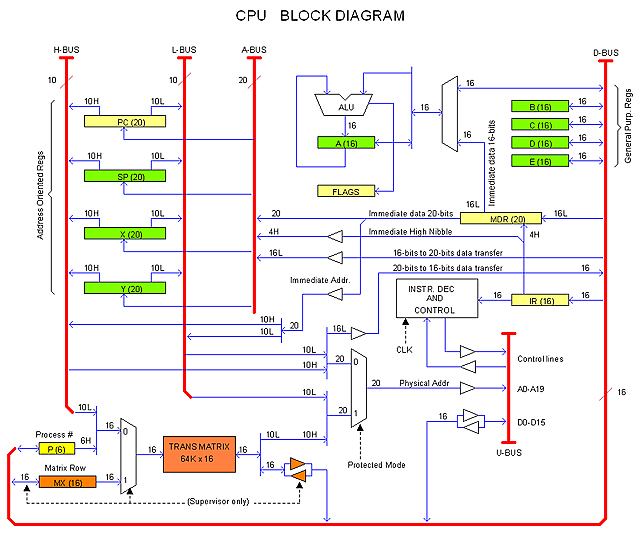The ComputerMain Features
Computer Name : Heritage/1
Data Bus : 16 bits
Address Bus : 20 bits (addresses point to 16 bit words)
Main Memory : SRAM 1 Mw (2 MB) max.
Arithmetic : Signed integer (two's complement)
Inst. decode method : Hard-wired logic using PLD chips
Operating Modes : Step, Real, Protected
Virtual Memory : Paging with Pages Tables in SRAM "Matrix" separate from Main Memory.
Page Frame size : 1Kw (2 KB)
Multitasking : Hardware support for up to 64 processes running in separate time-slices.
Software : None (Expected: Some Open Source Operating System)
Peripherals : Memory mapped
Interrupts : Vectored 256 max.
Nested ISR : Yes, based on priority
DMA : Yes
Technology : SSI/MSI HCMOS chips and PLDs
Construction : Prototyping boards with wires soldered (no wire-wrap) housing in 19" rackmount multi-card frames
Clock Speed : Pendig decision (expected: 12 MHz)
Computer Architecture
CPU Architecture
The figure below describes the Heritage/1 CPU architecture to the block level. I will explain how it works later. For now, you are invited to read my Notes. Remember that this design is in progress.
 Registers Registers
16-bits registers (Data oriented):
A Accumulator (Right operand and result for ALU operations)
B General purpose
C General purpose
D General purpose
E General purpose
20-bits Registers (Address oriented):
PC Program Counter (not directly addressable)
SP Stack Pointer (also a gernal purpose 20-bits register)
X Pointer for Indirect Address (also a gernal purpose 20-bits register)
Y Pointer for Indirect Address (also a gernal purpose 20-bits register)
Hidden Registers:
IR (16 bits) Instruction register
MDR (20 bits) Operand holder (both 16 and 20 bits)
FLAGS (?) Status flags
Supervisor Registers (Avilable in Real Mode. Also available for Supervisor code in Protected Mode):
P (6 bits) Current process when in Protected Mode.
MX (16 bits) Trans Matrix address
Important Note
This project is currenly on hold. I found that before continuing with a complex design such as that of Heritage/1, it would be better to start a simpler "pre-project" in which I could gain experience with basic Computer Design matters.
The info for the "pre-project" (currently in progress) is in the book titled PREHER-816.
| 

